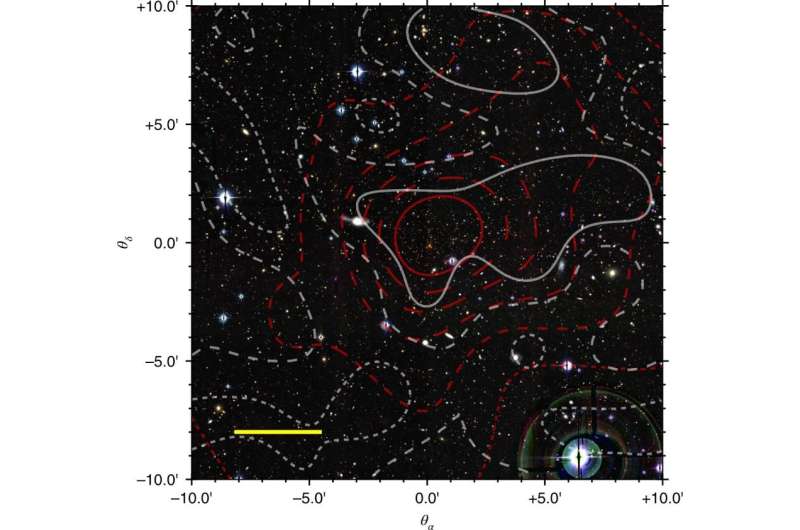July 20, 2018 report
Researchers study gravitational lensing around an extremely dense galaxy cluster

Dark matter halos are theoretical bodies inside which galaxies are suspended; the halo's mass dominates the total mass. These halos cannot be observed directly, but astronomers infer their presence by the phenomenon of gravity lensing—the distortion of background objects by strong gravitational sources that act as lenses. Astronomers can even study distant galaxies magnified by the gravitational lensing of closer gravitational objects.
Researchers have known for decades that the clustering of galaxies does not mirror the clustering of most of the matter in the universe. The concept that galaxy distribution correlates to matter density at a given site in the universe dates back to 1984. In a galaxy cluster, matter distribution is highly clustered, and halos form at the peak of this distribution. This is called the halo bias.
Halo bias can also be framed as the relationship between the spatial distribution of galaxies and the underlying dark matter density field. Clustering is enhanced relative to the general distribution of mass in the cluster. But there are other theorized properties besides mass that can affect clustering; physicists refer to these as secondary bias, but efforts at identifying them have been inconclusive.
Recently, a group of Italian researchers published a report in Nature Astronomy on a study of PSZ2 GO99.86+58.45, an extremely dense galaxy cluster with a very large gravitational lensing signal. They report that the system is extremely rare within the framework of galactic structure formation, and its characteristics strongly imply the effectiveness of enhancing mechanisms other than mass on dark matter halos.
The researchers analyzed data from two publicly available shear catalogs—the CFHTLenS and RCSLens. They found that the outskirts of the cluster have a very large gravitational lensing signal traceable up to 30 megaparsecs. Its high signal-to-noise ratio implies environment matter density that far exceeds the cosmological mean density. They report that the extreme density of this cluster cannot be attributed solely to mass.
Additionally, the researchers report that their findings agree well with the Lambda cold dark matter model (ΛCDM), which holds that the universe contains a cosmological constant denoted Λ associated with dark energy and cold dark matter. Cold dark matter is a hypothetical form of dark matter in which dark matter particles move slower than light. The ΛCDM model proposes that structure in the universe forms hierarchically from the bottom up, as smaller structures collapse under the influence of their own gravity, and continually merge into larger structures. It is currently the favored model for structure formation in the universe.
The researchers conclude by noting the utility of lensing analysis in the study of galaxy clusters. They write, "Next-generation galaxy surveys will routinely perform the lensing analysis of single halos out to very large radii, as we have presented here."
More information: Gravitational lensing detection of an extremely dense environment around a galaxy cluster. Nature Astronomy (2018). doi.org/10.1038/s41550-018-0508-y
Abstract
Galaxy clusters form at the highest-density nodes of the cosmic web. The clustering of dark matter halos hosting these galaxy clusters is enhanced relative to the general mass distribution, with the matter density beyond the virial region being strongly correlated to the halo mass (halo bias). Halo properties other than mass can further enhance the halo clustering (secondary bias). Observational campaigns have ascertained the halo bias, but efforts to detect this secondary bias for massive halos have been inconclusive. Here, we report the analysis of the environment bias in a sample of massive clusters, selected through the Sunyaev–Zel'dovich effect by the Planck mission, focusing on the detection of the environment dark matter correlated to a single cluster, PSZ2 G099.86+58.45. The gravitational lensing signal of the outskirts is very large and can be traced up to 30 megaparsecs with a high signal-to-noise ratio (about 3.4), implying environment matter density in notable excess of the cosmological mean. Our finding reveals this system to be extremely rare in the current paradigm of structure formation and, implies that enhancing mechanisms around high-mass halos can be very effective. Future lensing surveys will probe the surroundings of single haloes, enabling the study of their formation and evolution of structure.
Journal information: Nature Astronomy
© 2018 Phys.org





















